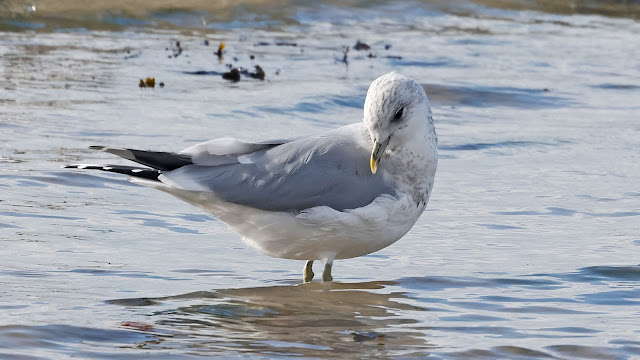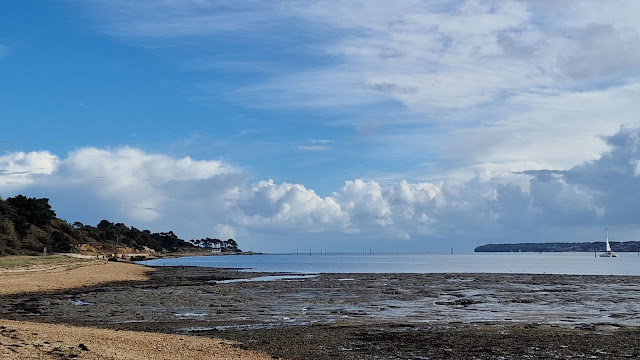Back in January 2014 I visited Lepe Country Park, at the time the main lens on my camera was away for repair and I was left with an old 200mm lens to photograph a Lesser Yellowlegs that was present on the pools. I haven't been back since, missing the Wryneck last year for work and holidays.
So I decided it was time to return, but as I approached I realised that this week was half-term, fortunately it was not too busy as I drove into the car park, later it filled up, but there was plenty of space to accommodate all.
When looking at the history and heritage of Lepe, it's
reasonable to start with the name of this tiny hamlet, part of the Exbury and
Lepe civil parish. It is said to derive from the Old English for a 'leaping
place', especially for deer: the site of a fence, maybe, or even a stream -
here the Dark Water river - over which energetic deer can jump. From 1575 until
1645 it was shown on old maps as Leape. It was shown as Leap from 1695 until at
least 1826, and then the current spelling was used in 1864 and it has remained
so ever since.
From the car I walked along the beach the tide was high but even so the Isle of Wight was close and had some threatening cloud above it.
Looking to the west there was a similar scene with some threatening clouds an indication of some indifferent weather to come.
On the beach there were Turnstone were searching amongst the shingle and sea weed on the tide line.
While a Pied Wagtail was on the groynes.
I left the beach and walked around the trails through the bushes and then back out on to the beach.
Looking across the Solent there was a very clear view of the Portsmouth skyline.
Here, behind the beach, is the pool that the Lesser Yellowlegs was on, those nine and a half years ago. Today there was a group of Redshank.
A single Grey Plover amongst the glasswort.
Nice reflections of this Curlew in the dark water.
A little further along a Little Egret was at the back of a smaller pool.
Looking out across the Solent towards the west, cloud was still hanging over the Isle of Wight, while above me and over Lee-on-the Solent it was clear blue sky and a very nice October day. The image in black and white adds to the dramatic scene.
The sea was dead calm and I picked up a bird offshore, looking closer I could see it was an auk and a Razorbill at that. I walked along the beach and it gradually drifted closer between dives with the classic wings drawn back and used to take the bird down as if flying.
Not a bird I get to see close up in the Solent so it was nice to have the opportunity this morning.
As it started to swim further away I decided to leave it having already had some great views. Walking back the Grey Plover had moved.
Walking back through the bushes there was an indicator of, despite the recent rain, how warm it has been, a Speckled Wood Butterfly.
I was conscious of a storm coming away to the west and returned to the car park. I decided to just explore the area to the west of the car park and keep close to the car that would provide shelter, I did not want to get wet all over again.
Looking away to the west you could make out the image of Hurst Castle looking like it was almost floating on the water, in front of it a group of Brent Geese.
I walked along the road beside the beach, on the other side is the Dark Water stream and a flooded meadow. On the river I liked this composition with the weir and its guard and a Oystercatcher.
The Oystercatcher then went to swim amongst the Brent off shore.
The view across Dark Water.
Ringed Plover and a single Dunlin flew past.
I sat on the sea wall close to the river outlet where a large number of Brent Geese had gathered, a chance to photograph them close in.
Very distinct neck markings on the individual in the foreground.
It then started to rain and I beat a retreat to the car, the time was right for lunch and then once the shower, which was quite heavy, moved through I set off once again towards Inchmery.
The tide had fallen quite a bit and there was exposed mud around the river outflow, plenty of Black-headed Gulls had gathered to pick through the shingle for shellfish and with them was this one Common Gull.
They similar head and neck markings, but just doesn't have the aggressive look of a Herring Gull in the winter.
Even though one set of showers had passed there was still the threat of more. Walking west there were some impressive clouds in front of me, but for now, thankfully they were over 50 miles away and there was the chance they would pass in land and miss all together.
There was initially a shingle path walking along the beach, but this became very soft with a cly soil which made the walk difficult. Wooden groynes zig zagged across the beach and around them were a pair of Rock Pipit that showed very well.
It was no surprise to see the continual stream of Red Admiral heading out over the water, this one settled on the beach.
A Kingfisher passed me close in, heading towards the exposed saltmarsh, off shore there were Oystercatcher and Curlew, while Cormorant could be seen on the mud, trying to look for the longed for White-tailed Eagle, of which there was no sign. I sat on a piece of drift wood and told myself that with time an eagle would appear, and I believed it, but unfortunately no one told the eagles.
So I spent my time taking in the breath-taking cloud formations and the still very warm October sunshine.
Looking across to Gull Island.
Looking west to the wonderful Needs Ore.
Finally I decided to start the walk back, heading towards a very Mediterranean scene.
The Curlew were feeding close in just off the beach, this one calling as if to say you are coming too close.
Oystercatcher were pretty much all the way along the water's edge, they seem to like doing things together with a symmetry.
I had passed some work being done on the fence in front of the cliff, and this was still going on as I came back. Heavy telegraph pole thick posts were being sunk in with a digger and tractor, and unbeknown to the men they were being watched from the water. Probably attracted to the noise, a Grey Seal was just off shore.
After one dive it surfaced and swam along showing the length of the body.
Still more Red Admiral appeared on the beach.
Walking back I took some time to look at Lepe House, a Lighthouse is in the grounds of the garden and was opened in 2000 to celebrate the millennium. Lepe House has been substantially added to over the years, but was probably more known for its service in World War Two. The House was requisitioned by the Navy in 1943 and became
the Headquarters of the J-Force Assault Group for the West Solent embarkations
before the D-Day Normandy landings. The concrete hard and access ramps, which
enabled tanks to be loaded onto landing craft, remain in evidence on the
foreshore.
I had been seeing Cormorants off shore and I would check them just in case they were something else. Just as I was to walk on I saw what I thought was another Cormorant, but something made me check as it looked a little smaller, as I did I saw the pointed up turned bill and realised that this wasn't a Cormorant but a Red-throated Diver.
Then just to confirm it wing flapped!
Then it started to drift away to the west and I ran after it to try and get as close as I could.
Not sure what this was sticking out, probably a stray feather.
The light was not good as it was almost directly behind the sun. This probably was the immature bird that was present off Warsash on Monday.
Here you can see a dark patch where the "red throat" would be.
Probably my favourite photograph.
Probably the best views I have had of Red-throated Diver in this country.
Here it was watching two crows as they called and flew over.
It then started to dive and move faster away, so I let it go quite happy that at last I had seen a diver this year.
I made my way to the river outlet where the tide was probably at its lowest.
At the water's edge there were Dunlin, Ringed Plover, Turnstone and a single Grey Plover, while closer in were several Carrion Crows and they had learnt to fly up and drop the various shellfish amongst the shingle and mud to crack them open, they were then able to get to the flesh inside.
I slowly walked out on the beach to try and get a little closer to the waders. They were not concerned with my presence and I was able to get low and to take some photographs of the Dunlin on the mud and in the water.
Always a watchful eye.
Or maybe two watchful eyes.
The over the shoulder look.
The ripples were coming in and as the Dunlin saw them approach they would lift themselves up as if to keep the water from their bellies, funnily I know somebody else like that.
Looking out to the west once more, Hurst Castle was still floating in the sea!
As I walked back a Rainbow appeared in land, confirming my suspicions that the showers that had earlier threatened had indeed moved in land and missed Lepe. The perfect end to a really good day with sightings I did not expect, but found very welcome.






































































No comments:
Post a Comment